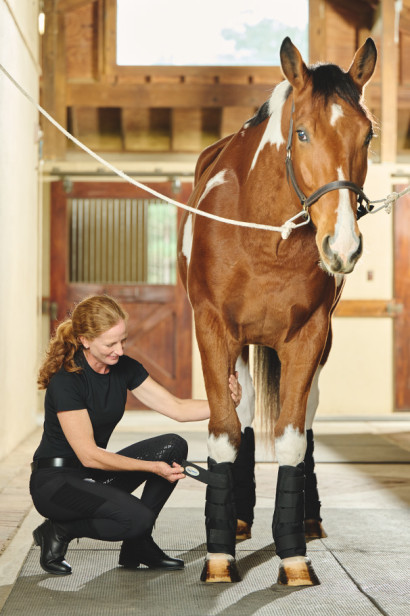Discover the Amazing Advantages of Equine Therapy for Psychological Recovery
Discover the Amazing Advantages of Equine Therapy for Psychological Recovery
Blog Article
Reviewing the Effectiveness of Laser Treatment in Equine Therapy for Injury Rehabilitation
The analysis of laser therapy's efficiency in equine injury rehabilitation pivots on numerous variables, including healing time, pain mitigation, and cells regrowth. Vets frequently observe premium outcomes with laser treatment contrasted to conventional techniques, positioning it as a crucial component in equine care.
Recognizing Laser Therapy
Laser treatment has ended up being a pivotal tool in vet medication, especially in the therapy of equine conditions. Recognized for its non-invasive nature and efficacy, laser treatment involves the application of specific wavelengths of light to boost cells repair work and reduce swelling. This healing method is significantly preferred for its capacity to increase the recovery procedure in equines dealing with a range of musculoskeletal injuries and persistent conditions.
The main device behind laser treatment is its capability to boost cellular functions. Furthermore, laser therapy promotes vasodilation, boosting blood flow and oxygen distribution to broken cells, hence expediting healing.
In equine medication, laser treatment is particularly beneficial for conditions such as tendonitis, osteo arthritis, and wound recovery. The technique is lauded for its pain-relieving buildings, permitting horses to gain back wheelchair and feature much more swiftly. Veterinarians also value its very little adverse effects compared to other therapy modalities, making it a trustworthy and risk-free choice for equine care.

How Laser Therapy Works

Upon absorption, these photons set off a collection of biochemical changes, boosting mitochondrial feature and leading to enhanced adenosine triphosphate (ATP) production. This increase in ATP accelerates cellular metabolic rate, advertising cells repair work and regrowth. Furthermore, laser treatment modulates inflammatory responses by impacting cytokine levels and lowering oxidative tension, therefore easing discomfort and swelling.
An additional significant element of laser treatment is its function in boosting microcirculation. The treatment promotes vasodilation, enhancing blood circulation and oxygen distribution to damaged cells (Equine Therapy). This promotes the removal of cellular debris and sustains the spreading of fibroblasts and collagen synthesis, vital for injury recovery
Medical Evidence
The effectiveness of laser therapy in equine treatment has actually been substantiated with numerous professional research studies, showcasing its therapeutic potential across an array of conditions. Numerous controlled trials and empirical researches have recorded considerable enhancements in tissue repair, discomfort decrease, and overall recovery timelines. A research study carried out by Turner et Equine Therapy al. (2012) showed that equines treated with low-level laser therapy (LLLT) for tendon injuries displayed accelerated healing contrasted to those getting standard therapies. The study highlighted a significant decrease in inflammation and improved collagen development.
Similarly, study by Johnson and colleagues (2015) focused on equine muscle mass injuries, disclosing that laser treatment considerably sped up muscle fiber regeneration and minimized muscle mass tightness. Professional analyses have revealed that laser therapy can minimize chronic problems such as osteoarthritis.
Veterinarian Insights

Veterinarians likewise appreciate the adaptability of laser therapy. It can be used for a variety of conditions, from shallow wounds to much deeper musculoskeletal injuries. Dr. Emily Brown highlights its energy in treating problems like tendonitis and osteoarthritis, where traditional therapies typically fail. She aims out that laser treatment can be tailored to the particular demands of each steed, making certain optimal outcomes.
Furthermore, veterinarians value the capacity to incorporate laser therapy with other treatment modalities. This multimodal approach can boost total therapy efficacy, offering a comprehensive service for weblink equine recovery. Such recommendations from skilled specialists highlight the expanding acceptance and application of laser treatment in equine medicine.
Practical Factors To Consider
An essential aspect of executing laser therapy in equine treatment involves comprehending the practical considerations that guarantee its efficiency and security. It is vital to pick the appropriate laser tool, as various types differ in wavelength, power, and penetration deepness. Veterinarians should be fluent in these specifications to customize therapy protocols properly per injury type
Additionally, the regularity and period of laser treatment sessions require mindful planning to optimize restorative benefits while reducing any kind of Visit Your URL possible negative results. Regular monitoring of the equine's reaction to treatment can lead essential adjustments in the treatment routine. Developing a secure and controlled environment throughout treatments is also necessary to stop accidental direct exposure to laser discharges, which could harm both the equine and the trainer.
Educating and accreditation of workers providing laser treatment are critical to make sure correct technique and to maintain security requirements. Furthermore, preserving accurate documents of each session, consisting of laser settings and observed results, is important for examining the overall efficiency of the therapy and for making data-driven choices.
Verdict
Laser treatment has actually emerged as an efficient method in equine injury recovery, providing substantial advantages in recuperation time, discomfort alleviation, and tissue recovery. For optimum outcomes, continuous surveillance and individualized therapy protocols stay important in leveraging the full capacity of laser therapy in equine care.
Report this page